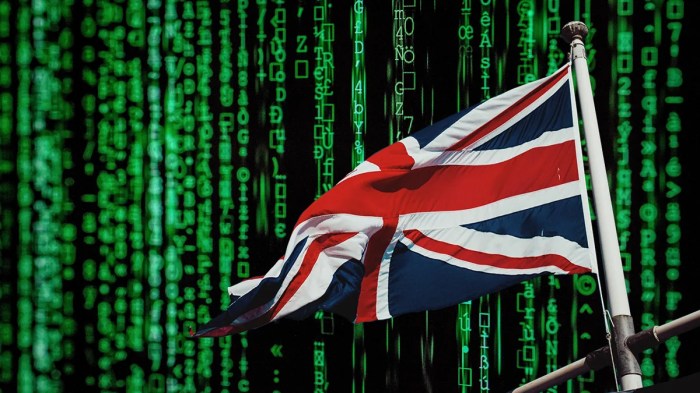
Microsoft Cyber Attacks UK AI: A Threat to National Security
Microsoft Cyber Attacks UK AI: A Threat to National Security – Imagine a world where critical infrastructure, from power grids to hospitals, is crippled by sophisticated cyberattacks, and the UK’s national security is at risk. This is the chilling reality we face as cybercriminals increasingly target Microsoft products, leveraging advanced AI techniques to breach defenses and disrupt operations.
The UK, heavily reliant on Microsoft technology, is a prime target for these attacks, making it imperative to understand the evolving threat landscape and implement robust security measures.
This blog delves into the complex world of Microsoft cyberattacks in the UK, examining the role of AI in escalating these threats and exploring the strategies employed by attackers. We’ll analyze the vulnerabilities exploited, the impact of successful attacks, and the crucial role of AI in both bolstering defenses and exacerbating the threat.
We’ll also explore the UK government’s initiatives to combat these attacks and discuss best practices for businesses to mitigate their risk.
Microsoft’s Role in UK Cybersecurity
Microsoft is a leading technology provider in the UK, playing a significant role in the country’s digital landscape. Its products and services are widely used by businesses, government entities, and individuals, making it a critical player in the UK’s cybersecurity ecosystem.
Microsoft Security Products and Services in the UK
Microsoft offers a wide range of security products and services designed to protect its users from cyber threats. These products and services are widely adopted by UK businesses and government entities, making them essential components of the UK’s cybersecurity infrastructure.
- Microsoft Defender for Endpoint: This endpoint protection platform provides comprehensive threat detection and response capabilities, safeguarding devices from malware, ransomware, and other cyberattacks.
- Microsoft Azure Security Center: This cloud-based security platform offers threat detection, vulnerability management, and security posture assessment for Azure resources.
- Microsoft 365 Defender: This suite of security solutions protects Microsoft 365 workloads, including email, collaboration, and identity, from advanced threats.
- Windows Security: This built-in security solution for Windows operating systems provides basic protection against malware and other threats.
Cybersecurity Threats Targeting Microsoft Products in the UK
While Microsoft’s security solutions are robust, they are not immune to cyberattacks. Various threats target Microsoft products, posing significant risks to UK businesses and government entities.
- Ransomware: This type of malware encrypts data and demands a ransom for its decryption.
- Phishing Attacks: These attacks use deceptive emails or websites to trick users into revealing sensitive information, such as login credentials.
- Data Breaches: Hackers may exploit vulnerabilities in Microsoft products to steal sensitive data, such as customer information or financial records.
- Zero-Day Exploits: These attacks target vulnerabilities in Microsoft products that are unknown to the company, allowing hackers to gain unauthorized access to systems.
Cyberattacks Targeting UK Businesses
The UK has become a prime target for cyberattacks, with businesses of all sizes facing significant threats. These attacks can have devastating consequences, leading to financial losses, reputational damage, and operational disruptions. State-sponsored actors are increasingly involved, utilizing sophisticated techniques to compromise sensitive data and critical infrastructure.
Examples of Successful Cyberattacks, Microsoft cyber attacks uk ai
These attacks highlight the vulnerability of UK businesses to cyber threats.
- In 2017, the NotPetya ransomware attack, attributed to the Russian government, caused billions of dollars in damages globally. The attack affected several UK businesses, including Maersk, a shipping giant, disrupting its operations for weeks.
- In 2020, a ransomware attack on the NHS, targeting its computer systems, led to the cancellation of thousands of appointments and procedures. The attack exploited vulnerabilities in Microsoft products, highlighting the importance of robust cybersecurity measures.
Methods and Tactics Used in Cyberattacks
Attackers employ various methods and tactics to exploit vulnerabilities in Microsoft products.
- Phishing:Attackers send emails or messages that appear to be from legitimate sources, tricking users into clicking malicious links or opening infected attachments. These links often lead to websites that steal login credentials or download malware onto the victim’s device.
The recent Microsoft cyberattacks in the UK have highlighted the growing threat of AI-powered attacks. It’s a sobering reminder that staying vigilant and adapting to these evolving threats is crucial. While the world grapples with these complex security challenges, I find solace in the creative outlet of watercolor painting.
Learning a few basic techniques, like those outlined in this article on 5 easy watercolor techniques , can help clear my mind and provide a welcome escape from the anxieties of the digital world. Perhaps by fostering a more creative mindset, we can better understand and address the challenges posed by AI in cybersecurity.
- Malware:Attackers use malware to gain unauthorized access to systems, steal data, or disrupt operations. This malware can be delivered through phishing emails, infected websites, or compromised software.
- Exploiting Vulnerabilities:Attackers often exploit vulnerabilities in Microsoft products, such as outdated software or misconfigured systems, to gain access. They may use known vulnerabilities or discover new ones through research and development.
- Denial-of-Service (DoS) Attacks:Attackers flood a target system with traffic, overwhelming its resources and making it unavailable to legitimate users. These attacks can disrupt business operations and damage the company’s reputation.
Exploiting Vulnerabilities in Microsoft Products
Attackers exploit vulnerabilities in Microsoft products to gain access to systems and steal data.
- Outdated Software:Attackers often target outdated software, which may contain known vulnerabilities. Businesses should regularly update their software to patch security holes and protect their systems.
- Misconfigured Systems:Misconfigured systems can expose vulnerabilities that attackers can exploit. Businesses should ensure their systems are properly configured and protected.
- Weak Passwords:Weak passwords can be easily guessed or cracked by attackers. Businesses should encourage employees to use strong passwords and multi-factor authentication to protect their accounts.
- Lack of Security Awareness:Employees who are unaware of cybersecurity threats are more likely to fall victim to attacks. Businesses should provide cybersecurity training to employees to help them identify and avoid threats.
The Role of AI in Cybersecurity
The integration of Artificial Intelligence (AI) into cybersecurity is revolutionizing how organizations defend against cyberattacks. AI’s ability to analyze vast amounts of data and identify patterns that humans might miss makes it a powerful tool for detecting and preventing threats.
Threat Intelligence and Anomaly Detection
AI plays a crucial role in enhancing threat intelligence by analyzing large datasets of cyberattacks, vulnerabilities, and malicious actors. This analysis helps security teams stay ahead of emerging threats by:
- Identifying attack patterns: AI algorithms can identify patterns in attack data, such as the techniques used, the targets, and the timing of attacks. This information can help security teams to predict future attacks and develop appropriate defenses.
- Detecting anomalies: AI can also be used to detect anomalies in network traffic, user behavior, and other data sources. These anomalies could indicate a potential attack or a compromise. For example, AI can analyze network traffic patterns and identify unusual spikes in activity that could signal a denial-of-service attack.
- Predictive threat analysis: AI can use historical data to predict future cyberattacks. This allows security teams to proactively take steps to mitigate risks and protect their systems. For example, AI can predict the likelihood of a phishing attack based on factors such as the target organization’s industry, size, and location.
Automating Security Tasks and Real-Time Threat Response
AI can automate various security tasks, freeing up human security professionals to focus on more strategic activities. This includes:
- Vulnerability scanning and patching: AI can automate the process of identifying and patching vulnerabilities in software and systems. This helps organizations to stay ahead of attackers who exploit known vulnerabilities.
- Incident response: AI can help security teams to respond to incidents more quickly and effectively. For example, AI can automatically isolate compromised systems and contain the spread of malware.
- Security monitoring: AI can monitor security systems 24/7, detecting threats and anomalies that might go unnoticed by human analysts. This allows security teams to respond to threats in real-time.
Benefits and Limitations of AI in Cybersecurity
AI offers significant benefits for cybersecurity, but it also has limitations that need to be considered.
- Benefits:
- Improved threat detection and prevention: AI can detect threats that might go unnoticed by humans, leading to better protection against cyberattacks.
- Enhanced security posture: AI can help organizations to improve their security posture by automating security tasks and responding to threats in real-time.
- Reduced costs: AI can automate many security tasks, reducing the need for expensive human resources.
- Limitations:
- AI bias: AI algorithms can be biased, which can lead to inaccurate results and potentially discriminatory outcomes. This is particularly important in security applications where AI decisions can have serious consequences.
- Explainability: It can be difficult to understand why AI algorithms make certain decisions, which can make it challenging to debug errors or identify potential biases.
- Data dependency: AI algorithms are only as good as the data they are trained on. If the data is inaccurate or incomplete, the AI model will be unreliable.
UK Government Initiatives and Policies: Microsoft Cyber Attacks Uk Ai

The UK government has taken a proactive approach to cybersecurity, recognizing the growing threat posed by cyberattacks, particularly those targeting Microsoft products. The government has implemented a comprehensive suite of policies and initiatives aimed at bolstering the nation’s cyber defenses, promoting responsible use of technology, and fostering collaboration among various stakeholders.
The recent Microsoft cyberattacks in the UK have highlighted the increasing sophistication of AI-driven threats. It’s a sobering reminder that we need to be vigilant in protecting our data. But hey, even amidst the digital chaos, a little self-care goes a long way.
Why not try a gold stud manicure DIY to lift your spirits? It’s a simple, fun way to feel empowered, and it’s a great way to unwind after a stressful day worrying about cyberattacks. After all, a strong mind needs strong nails, right?
Back to the cybersecurity topic, we must remember that the fight against these threats is ongoing, and we all have a role to play in staying safe online.
These initiatives are designed to enhance the resilience of UK businesses against cyberattacks, promote responsible use of technology, and encourage collaboration among various stakeholders.
Key Government Agencies and their Roles
The UK government has established a network of agencies dedicated to cybersecurity, each playing a distinct role in combating cyber threats.
- National Cyber Security Centre (NCSC):The NCSC, a part of GCHQ, is the UK’s national technical authority for cybersecurity. It provides advice, guidance, and support to organizations on how to protect themselves from cyberattacks. The NCSC also conducts research and development into new cybersecurity technologies.
The recent Microsoft cyberattacks in the UK have highlighted the importance of AI in cybersecurity. But sometimes, you just need a break from the digital world and focus on a more hands-on project, like learning how to add cane webbing to an Ivar cabinet.
It’s a surprisingly satisfying way to add a touch of vintage charm to your home and, who knows, maybe you’ll even find a new appreciation for the delicate craftsmanship of the past – a stark contrast to the ever-evolving world of cyber threats.
- Information Commissioner’s Office (ICO):The ICO is responsible for upholding information rights in the UK. It sets standards for data protection and enforces the UK’s data protection laws, ensuring that organizations handle personal data responsibly.
- National Crime Agency (NCA):The NCA is the UK’s lead agency for tackling serious and organized crime, including cybercrime. It investigates cyberattacks and works to disrupt criminal networks operating online.
- Department for Digital, Culture, Media and Sport (DCMS):The DCMS is responsible for developing and implementing the UK’s digital strategy, which includes cybersecurity. It works with other government agencies and industry stakeholders to promote cybersecurity and digital resilience.
Effectiveness of Government Initiatives
The effectiveness of UK government initiatives in mitigating cyber threats targeting UK businesses is a complex issue. While the government has made significant progress in raising awareness of cybersecurity risks and providing guidance and support to organizations, the threat landscape continues to evolve rapidly.
Some argue that the government’s approach has been effective in raising awareness of cybersecurity risks and providing guidance and support to organizations. Others suggest that more needs to be done to address the skills gap in cybersecurity and to provide adequate funding for cybersecurity initiatives.
The government’s initiatives have contributed to a significant increase in awareness of cybersecurity risks. However, challenges remain, including the need for more comprehensive cybersecurity education and training programs, as well as increased investment in research and development of new cybersecurity technologies.
Best Practices for Cybersecurity

In today’s digital landscape, cybersecurity is paramount for businesses of all sizes. The UK, being a hub for technological advancements, faces a constant threat from cyberattacks, particularly those targeting Microsoft products. This section Artikels essential best practices for UK businesses to bolster their cybersecurity posture and mitigate the risk of cyberattacks.
User Education
Effective cybersecurity starts with informed users. Educating employees about cybersecurity threats and best practices is crucial to preventing breaches.
- Regular Security Awareness Training:Implementing regular security awareness training programs for all employees is essential. These programs should cover topics like phishing, social engineering, password hygiene, and the importance of reporting suspicious activities.
- Phishing Simulations:Conducting phishing simulations is a valuable tool for testing employees’ ability to identify and report phishing attempts. These simulations help employees learn to recognize and avoid phishing emails and websites, ultimately reducing the risk of successful attacks.
- Clear Communication:Establishing clear communication channels for reporting security incidents is vital. Employees should be encouraged to report any suspicious activity or potential security breaches promptly.
Network Security
A robust network infrastructure is the foundation of a secure digital environment. UK businesses should implement the following network security best practices:
- Strong Passwords and Multi-Factor Authentication (MFA):Enforcing strong password policies and implementing multi-factor authentication (MFA) for all accounts, including administrative accounts, is critical. MFA adds an extra layer of security by requiring users to provide multiple forms of authentication, making it significantly harder for attackers to gain unauthorized access.
- Firewall Protection:Implementing a robust firewall is essential for blocking unauthorized access to your network. Firewalls act as a barrier between your network and the internet, filtering incoming and outgoing traffic and preventing malicious actors from entering your system.
- Network Segmentation:Segmenting your network into smaller, isolated sections can help limit the impact of a security breach. If one segment is compromised, the attacker will not have access to the entire network. This practice is particularly important for businesses with sensitive data, such as financial records or customer information.
- Regular Security Audits:Conducting regular security audits is crucial for identifying vulnerabilities and weaknesses in your network infrastructure. These audits should be performed by qualified security professionals who can assess your network’s security posture and provide recommendations for improvement.
Data Protection
Data protection is a critical aspect of cybersecurity, particularly in the wake of the GDPR. UK businesses must implement robust data protection measures to safeguard sensitive information.
- Data Encryption:Encrypting data at rest and in transit is essential for protecting sensitive information from unauthorized access. Encryption transforms data into an unreadable format, making it unusable to anyone without the appropriate decryption key.
- Regular Data Backups:Regularly backing up your data is essential for disaster recovery.
In the event of a cyberattack or other data loss event, having regular backups allows you to restore your data and minimize disruption to your business operations. Backups should be stored securely, preferably in a separate location from your primary data storage.
- Data Minimization:Only collect and store the data that is absolutely necessary for your business operations. This practice reduces the risk of sensitive information being compromised in the event of a breach.
Ongoing Security Assessments
Proactive security measures are crucial for mitigating cyber threats. Regular security assessments and vulnerability scans help identify and address security weaknesses before they can be exploited by attackers.
- Regular Vulnerability Scans:Conduct regular vulnerability scans to identify security weaknesses in your systems and applications. These scans can help you identify and patch vulnerabilities before they are exploited by attackers.
- Penetration Testing:Employ penetration testing to simulate real-world cyberattacks. This process involves ethical hackers attempting to penetrate your network and systems to identify security vulnerabilities and weaknesses. Penetration testing helps you identify and address vulnerabilities before attackers can exploit them.
- Security Monitoring:Implementing security monitoring tools is crucial for detecting and responding to security incidents. These tools can monitor network traffic, system logs, and user activity, providing real-time insights into potential threats.
Future Trends in Cybersecurity

The landscape of cybersecurity is constantly evolving, driven by technological advancements and the ever-changing tactics of cybercriminals. Artificial intelligence (AI) is playing a pivotal role in this evolution, both as a tool for enhancing defenses and as a weapon for attackers.
The Impact of AI on Cybersecurity
AI is revolutionizing cybersecurity by automating tasks, improving threat detection, and enabling more sophisticated defenses. AI-powered systems can analyze vast amounts of data to identify patterns and anomalies that may indicate malicious activity. This allows security teams to proactively identify and respond to threats, reducing the risk of successful attacks.
Potential Future Threats Targeting Microsoft Products and UK Critical Infrastructure
The UK’s critical infrastructure, including power grids, transportation systems, and communication networks, is increasingly reliant on technology, making it a prime target for cyberattacks. Attackers are constantly seeking new ways to exploit vulnerabilities in Microsoft products, which are widely used in the UK.
Examples of Potential Threats
- AI-powered phishing attacks: These attacks use AI to create highly personalized and convincing phishing emails, making them more likely to be successful.
- AI-driven malware: AI can be used to develop malware that is more difficult to detect and remove, making it more effective in stealing data or disrupting operations.
- AI-powered social engineering attacks: AI can be used to create sophisticated social engineering attacks that exploit human psychology and emotions, making them more persuasive and successful.
- Attacks targeting critical infrastructure: Attackers may use AI to target critical infrastructure, such as power grids, transportation systems, and communication networks, with the goal of causing widespread disruption or damage.
Strategies for Mitigating Future Threats
To counter these emerging threats, organizations must adopt a proactive and comprehensive approach to cybersecurity.
Strategies
- Invest in AI-powered security solutions: Organizations should invest in AI-powered security solutions to enhance threat detection, prevention, and response capabilities.
- Develop a strong cybersecurity culture: Organizations should cultivate a strong cybersecurity culture that emphasizes employee awareness, training, and responsible use of technology.
- Embrace collaboration and information sharing: Organizations should collaborate with government agencies, industry partners, and other stakeholders to share information and best practices, enabling collective defense against cyber threats.
- Foster innovation and research: Organizations should invest in research and development to stay ahead of emerging threats and develop new cybersecurity technologies.
The Importance of Collaboration and Innovation
Collaboration and innovation are essential for effectively mitigating future cybersecurity threats. By working together, organizations, governments, and researchers can share knowledge, develop new technologies, and build a more resilient cybersecurity ecosystem.


